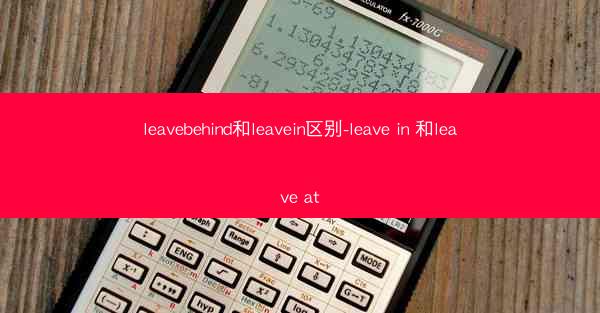leavebehind和leavein区别-leave in 和leave at
分类:帮助中心 | 发布时间:2025-03-17 11:09 | 来源:纸飞机下载

在英语中,leave behind和leave in是两个常见的短语动词,它们在用法和意义上有所区别。我们来明确这两个短语的含义。
Leave behind意为留下,通常指的是在离开某个地方或结束某个活动时,有意或无意地遗留下某些物品或痕迹。
Leave in则意味着留下,但它的用法更为具体,通常指的是在某个过程中,将某种物质或成分留在某个地方或某个物体上。
二、用法区别
1. 情境使用:
- Leave behind通常用于描述在离开某个地方时遗留下的物品,如:Don't forget to leave behind your keys when you go out.
- Leave in则常用于描述在某个过程中保持某种物质或成分,如:You can leave in the conditioner in your hair for a few minutes before rinsing.
2. 动作主体:
- Leave behind强调的是动作的执行者有意或无意地遗留下某物。
- Leave in则强调的是某种物质或成分被有意地留在某个地方。
3. 语境差异:
- 在描述旅行或搬家时,我们常用leave behind:When we moved to a new house, we left behind all our old furniture.
- 在描述个人护理或烹饪时,我们常用leave in:After washing your hair, you can leave in the hair mask for 20 minutes.
三、具体例子
1. 旅行中的使用:
- I accidentally left behind my passport at the hotel.
- Don't leave your luggage behind at the airport.
2. 个人护理:
- After washing your face, leave the moisturizer on for a few minutes before rinsing it off.
- You can leave in the sunscreen on your skin before going outside.
3. 烹饪过程:
- When making pasta, leave the sauce on the pasta for a few minutes to let the flavors meld together.
- Don't leave the salt behind when seasoning your food.
四、语法结构
1. Leave behind:
- 通常结构为:Subject + leave + Object + behind
- 例如:I left my phone behind at home.
2. Leave in:
- 通常结构为:Subject + leave + Object + in
- 例如:She left the cream in her hair.
五、文化差异
在不同的文化背景下,这两个短语的用法可能有所不同。例如,在一些文化中,人们可能更倾向于使用leave behind来描述遗留下来的物品,而在另一些文化中,可能更常用leave in来描述留下某种成分。
六、语境理解
在理解和使用这两个短语时,我们需要根据具体的语境来判断其含义。例如,在对话中,说话者的语气和上下文都可能帮助我们确定是使用leave behind还是leave in。
七、常见错误
在使用这两个短语时,常见的错误包括:
- 将leave behind误用为leave in:Don't leave your phone in the car.
- 将leave in误用为leave behind:Make sure to leave the cream behind after washing your hair.
Leave behind和leave in虽然都含有留下的意思,但它们的用法和语境有所不同。了解这两个短语的含义和用法,有助于我们在日常交流中更加准确、得体地表达自己的意思。
相关内容推荐:
- 2025-03-11 22:27telegram mtproto账号-telegram account
- 2025-03-24 11:58telegramiOS登陆教学-telegram登录流程
- 2025-03-22 20:35telegram.cn-telegramcn.me
- 2025-03-18 23:22office家庭版2024有什么用处-office家庭版会过期吗
- 2025-03-18 06:11leave是什么意思英语怎么说-leaves的英文是什么意思
- 2025-03-09 21:08telegram驗證短信在哪查看
- 2025-03-10 02:54Telegran怎麽設置中文模式
- 2025-03-19 21:48official怎么读语音-officials读音
- 2025-03-15 02:48telegram 好用吗-telegram 干嘛的
- 2025-03-16 18:04grow什么意思-grown-up什么意思
- 推荐阅读
- 最热文章